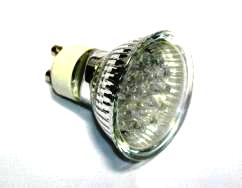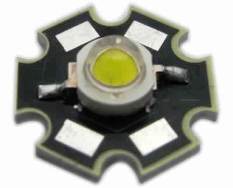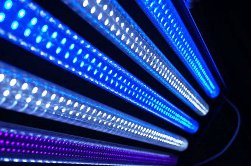Categories: Interesting electrical news, Sources of light
Number of views: 59259
Comments on the article: 9
LED lightening. All the pros and cons
 The abbreviation LED is derived from the English phrase Light Emitting Diode, which means a diode that emits light. In other words, A light emitting diode is a semiconductor device that converts the electric current passing through it into light radiation.
The abbreviation LED is derived from the English phrase Light Emitting Diode, which means a diode that emits light. In other words, A light emitting diode is a semiconductor device that converts the electric current passing through it into light radiation.
The main element of the LED is an artificial semiconductor crystal. It comes in red, yellow, green and blue. This part is placed in a copper or aluminum cup, which also acts as a reflector and cathode. A golden thread is welded to the crystal, which serves as the anode. All this is filled with a transparent compound and give it the necessary shape..
To ensure stable operation of the device, the LEDs are placed on a printed circuit board, which has an electronic circuit. The simplest lighting fixture is an LED module that has its own contacts.
 The next type is LED modulewhich is equipped with an electronic current stabilizer. There are RGB-modules, which are based on the diodes of red (Red), green (Green) and blue (Blue) colors. These modules have a special controller that allows you to mix colors in different proportions. This gives him the opportunity to shine with all the colors of the rainbow.
The next type is LED modulewhich is equipped with an electronic current stabilizer. There are RGB-modules, which are based on the diodes of red (Red), green (Green) and blue (Blue) colors. These modules have a special controller that allows you to mix colors in different proportions. This gives him the opportunity to shine with all the colors of the rainbow.
Until the 90s there were only red, yellow and green diodes. To get white or other color shades, a combination of green, blue and red is needed. Low-cost blue LEDs were required that would consume a small amount of energy and give a good light output. Gallium, aluminum and indium nitrides came to the rescue. Cheap blue LEDs based on them were invented by a Japanese inventor.
Using LEDs, you can create luminous ornaments, letters, etc. Quite often, LED rulers are performed, in which from several pieces to three dozen LED modules can be controlled by the controller. They can be either one or different colors.
 LED rulers illuminate the garden, the facade of the house, stairs. This backlight has a low operating temperature, which is why it is even used to highlight ice figures and snowy branches of spruce in the yard.
LED rulers illuminate the garden, the facade of the house, stairs. This backlight has a low operating temperature, which is why it is even used to highlight ice figures and snowy branches of spruce in the yard.
LED modules are used in signal devices, flashlights, advertising signs, information boards, etc.
About ten years ago, the first LED lights. Initially, such lighting was much weaker than that of lamps with conventional incandescent lamps and they could only be used as a night lamp. Currently, LED lights are available that can be used for general lighting.
Modern LED lamps displace lamps with other light sources (incandescent, fluorescent lamps) not only from domestic (home) lighting. They are actively used in lighting office buildings and industrial enterprises.
LED devices are easy to connect. Even the connection diagram of the LED line, which consists of many elements, is quite simple. When one or more LEDs fail, the operation of the device does not stop. Replacing them is pretty easy.
 LEDs withstand temperature fluctuations, noise and vibration. LED modules have a life of about 100 thousand hours, or 10 years of continuous operation, subject to the acquisition of high-quality goods and the literacy of installation work. Their light, not even the brightest, is visible for a considerable distance.
LEDs withstand temperature fluctuations, noise and vibration. LED modules have a life of about 100 thousand hours, or 10 years of continuous operation, subject to the acquisition of high-quality goods and the literacy of installation work. Their light, not even the brightest, is visible for a considerable distance.
LED modules are only gaining popularity. This is due to the fact that compared to conventional incandescent lamps and neon tubes, they have a higher cost.Another drawback of LED modules is their miniaturization. Creating large structures, you have to use a lot of LEDs.
LED Lighting (LED lightening) combines quality and beauty, allows you to show the unusual capabilities of such lighting.
See also on our website:
How to choose the right LED lamp for the home
How to choose the right LED lamp for power
See also at bgv.electricianexp.com
:
